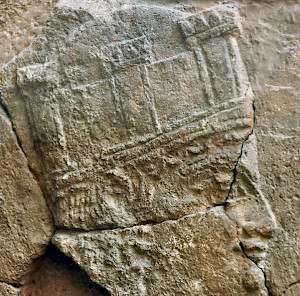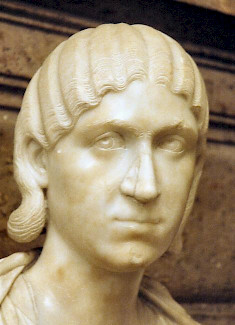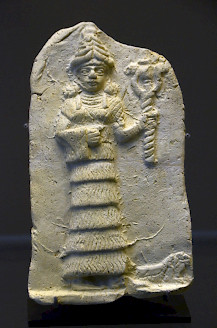Semiramis
Semiramis (Greek: Σεμίραμις): legendary queen of Assyria and founder of Babylon, known from Greek, Armenian, and Jewish sources.
The name

The name Semiramis is historical. The wife of the Assyrian king Šamši-Adad V (r.824-811 BCE) was called Šammuramat, which is correctly rendered in Greek as Semiramis. When Šammuramat’s husband died, she acted as regent for her underage son Adad-Nirari III for three (maybe five) years. During these years, the Assyrian armies waged war against the Medes in the east and the city of Arpad in the west. In Assyria, war was normal business, be it that the commander was a woman or a general designated by this woman. As we will see below, the Medes may have had reasons to remember the campaigns of the final years of the ninth century BCE. This is about all we know about Šammuramat, except that in 787 BCE, she was still alive.
Greek story
The Greeks knew her name, although their queen Semiramis is a largely legendary character, much like their Indians, their Nubians, their Celts, their Scythians, and their Assyrians, who were often just semi-legendary names. The first to mention Semiramis is the Greek researcher Herodotus of Halicarnassus, who tells us that she had the banks of the river Euphrates fortified and also mentions that a city gate in Babylon was named after her.note
The actual story pops up a little later, with the Greek author Ctesias of Cnidus. Although his works are largely lost, his story of queen Semiramis is retold by Diodorus of Sicily.note Summarized, he says that Semiramis was a daughter of the Syrian goddess Derceto, that she was fed by pigeons as a child, and that she was found and raised by shepherds. She later married a man named Onnes, ended up at the Assyrian court in Nineveh and accompanied king Ninus during his campaign to Bactria. After conquering a mountain fortress with a ruse, she married her king. (Her first husband had already committed suicide.)
A little later Ninus also died and Semiramis became queen. For her second husband, she built a huge mausoleum. She also founded Babylon, a city full of miraculous buildings (e.g., an obelisk), and decorated Ecbatana in Media, where she had one lover after another and had them all killed. After founding some cities in Persia, Semiramis subdued Egypt, returned to Bactria, and invaded India.
When this campaign ended in failure, she abdicated, after which she was mysteriously taken up among the gods. The woman who in fact would have been the founder of the Assyrian Empire was henceforth venerated in the guise of a pigeon.
Roman slander

This story – and similar ones – were well known in Antiquity. The fourth-century writer Eutropius, could play with it. He mentions a woman named Symiasera, by which he means Julia Soeamias, an empress born in Syria. The weird spelling is no coincidence: Eutropius wants to recall the legendary Semiramis of Assyria.
Jewish Midrash
In the Jewish tradition,note Semiramis is presented as consort of the Babylonian king Nebuchadnezzar. With Herodotus' narration, this is the most down-to-earth version of all. In later Jewish stories, Semiramis has become the wife of Nimrod, a ruler in the Middle East mentioned in Genesis.note In Late Antiquity, many ancient ruins were named after him. note In popular culture, Nimrod and Semiramis were figures whose names were quite easy to applyw to ancient ruins and they attracted all kinds of stories, much like in Britain all kinds of places are associated with the equally legendary king Arthur.
Armenian legend
As a consequence, there were many versions of the Semiramis legend, such as the Armenian one, which can be found in the books by Moses of Chorene, the early medieval author of a well-known History of Armenia. In his version of the story, Semiramis is in love with Ara the Handsome, a legendary king of Armenia. However, he rejects her advances and she declares war. Somewhere on the plain of Artaxata, a battle ensues in which King Ara is killed, despite Semiramis’ instructions to capture him alive.
In a second part of the Armenian legend, Semiramis builds a castle in Armenia and retreats there, leaving dominion to a courtier, Zoroaster. He rebels and besieges his queen, but she flees further into Armenia and is eventually killed by her son.
Rise of a legend

The German scholar Carl Lehmann-Haupt (1861-1938) proposed an interesting theory about the origins of the Semiramis legend. He believed that the story originated in the east, with the Medes, who fought endlessly with the Assyrians. Since their first acquaintance with the Assyrian power took place at the time of queen Šammuramat, the Medes believed that she was the founder of the Assyrian Empire.
In Persian Mesopotamia, the already legendary figure merged with the love goddess Ištar, which explains Semiramis’ erotic adventures. Furthermore, there are of course all kinds of additions recognizable from the Eastern legendary literature, such as the insatiable nymphomaniac who has her partners killed (a motif already recognized in the Epic of Gilgameš). The Medes may have passed the subject matter to the Persians, where Ctesias must have heard it.